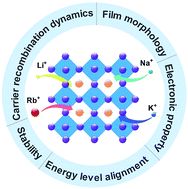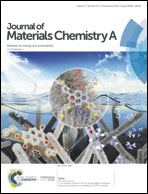Emerging alkali metal ion (Li+, Na+, K+ and Rb+) doped perovskite films for efficient solar cells: recent advances and prospects
Abstract
Metal halide perovskite materials have drawn worldwide attention for application in a variety of optoelectronic devices, especially in the emerging photovoltaic devices. In recent years, remarkable progress has been achieved in the device performance and stability. The optoelectronic properties of metal halide perovskites can be further tuned by ion doping. Herein, a comprehensive review of the incorporation of alkali metal ions (Li+, Na+, K+ and Rb+) in emerging perovskite solar cells for a longer carrier lifetime, lower interfacial defect density, faster charge transfer, no hysteresis, higher stability and higher power conversion efficiency is presented. The detailed mechanism behind these beneficial effects has been discussed in terms of electronic properties, film morphology, energy level alignment, carrier recombination dynamics and stability. On the basis of these latest advances and breakthroughs in alkali ion doped perovskite thin films, future research directions and prospects are also discussed, which include further understanding of the underlying photophysical mechanism and extension to other optoelectronic devices where a longer carrier lifetime and lower trap density are needed.

- This article is part of the themed collection: Recent Review Articles


 Please wait while we load your content...
Please wait while we load your content...